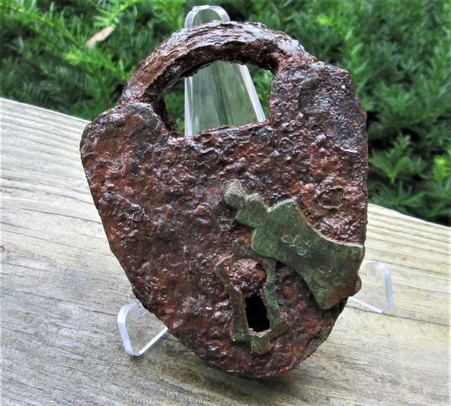 Loading... Please wait...
Loading... Please wait...-
Call us on (973) 810-2976
- My Account
- Gift Certificates
- Items / $0.00
All prices are in All prices are in USD
Categories
- Home
- Sold, Hold, Layaway items
- Large Civil War Pad Lock from Goldsboro, NC (SOLD)
Large Civil War Pad Lock from Goldsboro, NC (SOLD)
Out of Stock
Product Description
This is another piece which I acquired directly from the digger during a buying trip down south, it is the last of the three locks he had. It is an iron padlock with a brass face plate, measuring 4” x 3”. It is frozen in the locked position, as found. The sliding brass cover has the crown and some letters, this would indicate being manufactured in England. Many items came through blockade runners from England to supply the Confederacy; there is a good chance that is how this lock originated.
These locks were used by both sides to keep Artillery ammunition crates secure and also by the Quartermaster to keep supplies locked up. Similar examples can be found in "Civil War Artifacts - A Guide for the Historian", by Howard Crouch (see pictures). This is one of the three that were recovered at a site where both Union and Confederate troops were located in Goldsboro, NC.
The bloodiest Civil War battles fought in North Carolina were on the way to Goldsboro. Twice during the war, the Union targeted this city for its railroads and the supplies they carried. In December 1862, both the Union Army and Confederate forces desired to secure the strategically significant Wilmington and Weldon Railroad Bridge. On December 17, an expedition under Union Maj. Gen. John G. Foster reached the railroad near Everettsville, aiming to destroy this bridge in order to put an end to the vital supply chain from the port of Wilmington.
Foster's men began destroying the tracks north toward the Goldsboro Bridge. Confederate forces delayed the advance but were unable to prevent the destruction of the bridge. Foster's troops overpowered the small number of defending Confederate soldiers and successfully burned down the bridge. His mission accomplished, Foster departed to return to their base at New Bern. On their way back, Foster's men were again attacked by Confederate forces, but they repulsed the assault, taking far fewer casualties than the enemy.
Goldsboro was occupied by General Sherman and his 100,000 plus troops during the weeks of March and April of 1865. This lock has been varnished for preservation and is now pretty solid.



